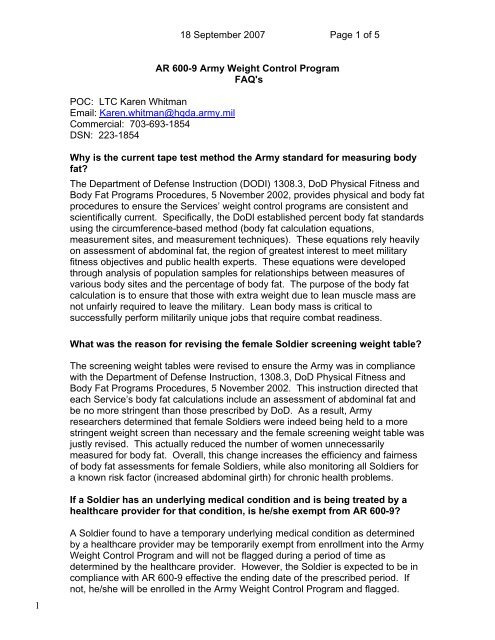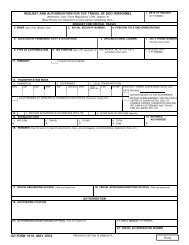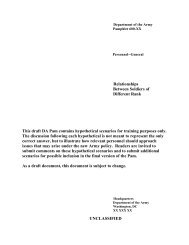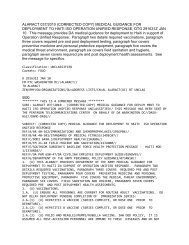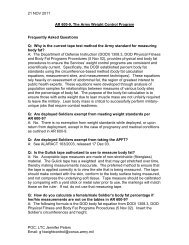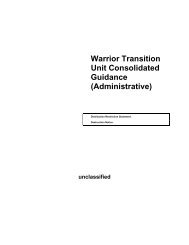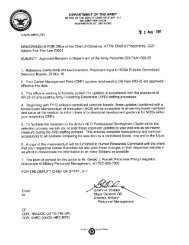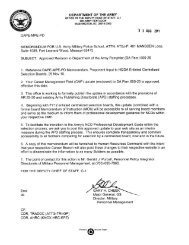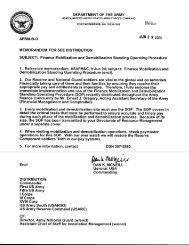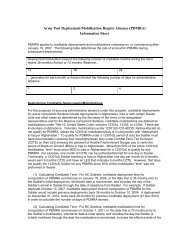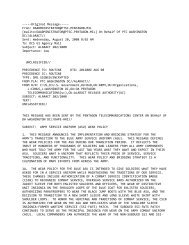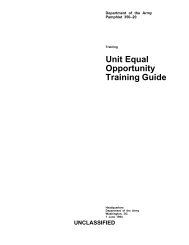2 - Deputy Chief of Staff ARMY G-1 - U.S. Army
2 - Deputy Chief of Staff ARMY G-1 - U.S. Army
2 - Deputy Chief of Staff ARMY G-1 - U.S. Army
Create successful ePaper yourself
Turn your PDF publications into a flip-book with our unique Google optimized e-Paper software.
1<br />
POC: LTC Karen Whitman<br />
Email: Karen.whitman@hqda.army.mil<br />
Commercial: 703-693-1854<br />
DSN: 223-1854<br />
18 September 2007 Page 1 <strong>of</strong> 5<br />
AR 600-9 <strong>Army</strong> Weight Control Program<br />
FAQ's<br />
Why is the current tape test method the <strong>Army</strong> standard for measuring body<br />
fat?<br />
The Department <strong>of</strong> Defense Instruction (DODI) 1308.3, DoD Physical Fitness and<br />
Body Fat Programs Procedures, 5 November 2002, provides physical and body fat<br />
procedures to ensure the Services’ weight control programs are consistent and<br />
scientifically current. Specifically, the DoDl established percent body fat standards<br />
using the circumference-based method (body fat calculation equations,<br />
measurement sites, and measurement techniques). These equations rely heavily<br />
on assessment <strong>of</strong> abdominal fat, the region <strong>of</strong> greatest interest to meet military<br />
fitness objectives and public health experts. These equations were developed<br />
through analysis <strong>of</strong> population samples for relationships between measures <strong>of</strong><br />
various body sites and the percentage <strong>of</strong> body fat. The purpose <strong>of</strong> the body fat<br />
calculation is to ensure that those with extra weight due to lean muscle mass are<br />
not unfairly required to leave the military. Lean body mass is critical to<br />
successfully perform militarily unique jobs that require combat readiness.<br />
What was the reason for revising the female Soldier screening weight table?<br />
The screening weight tables were revised to ensure the <strong>Army</strong> was in compliance<br />
with the Department <strong>of</strong> Defense Instruction, 1308.3, DoD Physical Fitness and<br />
Body Fat Programs Procedures, 5 November 2002. This instruction directed that<br />
each Service’s body fat calculations include an assessment <strong>of</strong> abdominal fat and<br />
be no more stringent than those prescribed by DoD. As a result, <strong>Army</strong><br />
researchers determined that female Soldiers were indeed being held to a more<br />
stringent weight screen than necessary and the female screening weight table was<br />
justly revised. This actually reduced the number <strong>of</strong> women unnecessarily<br />
measured for body fat. Overall, this change increases the efficiency and fairness<br />
<strong>of</strong> body fat assessments for female Soldiers, while also monitoring all Soldiers for<br />
a known risk factor (increased abdominal girth) for chronic health problems.<br />
If a Soldier has an underlying medical condition and is being treated by a<br />
healthcare provider for that condition, is he/she exempt from AR 600-9?<br />
A Soldier found to have a temporary underlying medical condition as determined<br />
by a healthcare provider may be temporarily exempt from enrollment into the <strong>Army</strong><br />
Weight Control Program and will not be flagged during a period <strong>of</strong> time as<br />
determined by the healthcare provider. However, the Soldier is expected to be in<br />
compliance with AR 600-9 effective the ending date <strong>of</strong> the prescribed period. If<br />
not, he/she will be enrolled in the <strong>Army</strong> Weight Control Program and flagged.
2<br />
18 September 2007 Page 2 <strong>of</strong> 5<br />
If a Soldier is taking a prescribed medication that may cause weight gain is<br />
he/she exempt from the standards <strong>of</strong> AR 600-9?<br />
No. The use <strong>of</strong> certain medications to treat an underlying medical disorder or the<br />
inability to perform aerobic events may contribute to weight gain, but neither is<br />
generally considered sufficient medical rationale to exempt a Soldier from<br />
AR 600-9.<br />
When and for how long is a pregnant Soldier exempt from AR 600-9?<br />
Pregnant Soldiers are exempt from the standards <strong>of</strong> AR 600-9 for the duration <strong>of</strong><br />
pregnancy plus 6 months following pregnancy termination. When initially informed<br />
<strong>of</strong> the pregnancy, the Soldier shall continue her physical fitness program under the<br />
supervision <strong>of</strong> medical authority. It is recommended that the Services <strong>of</strong>fer a<br />
pregnancy postpartum physical training program at each installation. Information<br />
about the U.S. <strong>Army</strong> Center for Health Promotion and Preventive Medicine’s<br />
program may be found at: http://chppm-www.apgea.army.mil/.<br />
If a Soldier miscarries her baby, what is the guidance in regards to her APFT<br />
and weigh-in?<br />
The Department <strong>of</strong> Defense Directive 1308.1, 20 July 1995, Physical Fitness and<br />
Body Fat Program, states pregnant service members shall not be held to the<br />
standards <strong>of</strong> fitness and body fat testing until at least 6 months after pregnancy<br />
termination. In accordance with AR 40-501 Chapters 7-10, convalescent leave<br />
after a termination <strong>of</strong> pregnancy (for example, miscarriage) will be determined on<br />
an individual basis by the attending physician.<br />
Are deployed Soldiers exempt from meeting weight standards per AR 600-9?<br />
No. There is no exemption from weight standards while deployed, or upon return<br />
from deployment.<br />
When will a Soldier be flagged for being overweight?<br />
In accordance with AR 600-9, paragraph 3-2b, a Soldier who exceeds the body fat<br />
standard will be informed by his/her unit Commander that he/she has been<br />
entered into the <strong>Army</strong> Weight Control Program (AWCP). The date on which that<br />
counseling occurs is the effective date he/she is enrolled in the AWCP and flagged<br />
under the provisions <strong>of</strong> AR 600-8-2. Prior to or shortly after enrollment into the<br />
AWCP, that Soldier will also be provided dietary education or nutrition counseling<br />
by healthcare personnel, exercise guidance, and assistance in behavioral<br />
modification, as appropriate, to help him/her meet <strong>Army</strong> requirements.<br />
Are medical evaluations required before a Soldier is flagged?<br />
No. However, in accordance with AR 600-9, paragraph 3-2d, a medical evaluation<br />
will be completed when the Soldier has a medical limitation, or is pregnant, or
3<br />
18 September 2007 Page 3 <strong>of</strong> 5<br />
when requested by the unit commander. A medical evaluation is also required for<br />
Soldiers being considered for separation as a result <strong>of</strong> failing to make satisfactory<br />
progress in a weight control program, or who are within six months <strong>of</strong> ETS. It is<br />
recommended that all Soldiers who are enrolled in a weight control program<br />
receive a medical evaluation. However, a medical evaluation does not exclude the<br />
Soldier from meeting body fat standards per AR 600-9.<br />
Can the commander or attending physician approve exemptions to<br />
AR 600-9?<br />
No. The <strong>Deputy</strong> <strong>Chief</strong> <strong>of</strong> <strong>Staff</strong>, G-1, Human Resources, is the proponent for the<br />
<strong>Army</strong> Weight Control Program (AWCP). All exemptions to AR 600-9 must be<br />
forwarded to: <strong>Deputy</strong> <strong>Chief</strong> <strong>of</strong> <strong>Staff</strong>, G-1 (ATTN: DAPE-HRI), 300 Pentagon,<br />
Washington, DC 20310. Commanders must provide counseling to Soldiers to<br />
establish a personal weight goal and implement the AWCP. Health care<br />
personnel assist commanders and supervisors by providing weight reduction<br />
counseling, identification <strong>of</strong> pathological conditions that require medical<br />
treatment, and evaluating Soldiers with medical limitations. The DA Form 3349,<br />
Physical Pr<strong>of</strong>ile form, will not be used to excuse Soldiers from the provisions <strong>of</strong><br />
AR 600-9. AR 600-9 contains a standard memorandum for completion by a<br />
physician if there is an underlying or associated disease process that is the cause<br />
<strong>of</strong> the overweight condition.<br />
What is the process to request a waiver to AR 600-9?<br />
All waiver requests must be endorsed by your commander or senior leader and forwarded<br />
through your higher headquarters to the <strong>Army</strong> G-1. Your request must be accompanied by<br />
pertinent medical documentation from your physician. This information is then forwarded<br />
to the Office <strong>of</strong> the Surgeon General who reviews and renders a medical opinion. Forward<br />
requests along with supporting medical documentation (including any treatment received)<br />
from your primary healthcare provider via email to: Karen.whitman@hqda.army.mil; or fax<br />
(703) 695-6988 (please call first); or mail documents to:<br />
<strong>Deputy</strong> <strong>Chief</strong> <strong>of</strong> <strong>Staff</strong>, G-1<br />
ATTN: DAPE-HRI<br />
300 <strong>Army</strong> Pentagon<br />
Washington, DC 20310<br />
Is the Gulick tape authorized to use to measure body fat?<br />
No. AR 600-9, Appendix B-1.d states that acceptable tape measures are made <strong>of</strong><br />
nonstretchable material. The Gulick tape has a spring loaded end that may be<br />
used to ensure that the same amount <strong>of</strong> pressure is exerted on the tape (and<br />
hence the measurement site) when measuring body fat. Unfortunately, this spring<br />
can get stretched over time thereby making measurements inaccurate. The<br />
preferred method to ensure that the tape is applied correctly is to view the site that<br />
is being measured. The tape should make contact with the skin, conform to the<br />
body surface being measured, and not compress the underlying s<strong>of</strong>t tissue (fat).
4<br />
18 September 2007 Page 4 <strong>of</strong> 5<br />
How do you calculate a female/male Soldier's body fat percentage if her/his<br />
measurements are not on the tables in AR 600-9?<br />
The following formula is the DoD body fat equation from the Department <strong>of</strong><br />
Defense Instruction 1308.3, "DoD Physical Fitness and Body Fat Programs<br />
Procedures", 5 November 2002. Insert the Soldiers' circumferences and height.<br />
NOTE: You will need to use a scientific calculator, which you will find on your<br />
computer. (Pull up calculator from programs and then click on VIEW and<br />
choose “Scientific”.)<br />
WOMEN: The equation* for women is:<br />
% body fat = [163.205 x log (waist + hip - neck)] - [97.684 x log (height)] - 78.387<br />
*Circumference and height measurements must be in inches.<br />
SAMPLE: Neck = 15.0"; Waist = 42"; Hip = 44"; Height = 64"<br />
% body fat = [163.205 x log (42 + 44 -15)] - [97.684 x log (64)] - 78.387<br />
A. Solve: [163.205 x (Log (71)). Take the Log (71) = 1.85 (when using a calculator be<br />
careful not to use LN (natural log). Instead, enter 71 and press the LOG key.<br />
B. Solve [97.684 x (Log (64)). Take the Log (64) = 1.81 (when using a calculator be<br />
careful not to use LN (natural log). Instead, enter 64 and press the LOG key.<br />
C. Solve the equation:<br />
% body fat = [163.205 x 1.85 - [97.684 x 1.81 - 78.387]<br />
= [301.93] - [176.81 - 78.387]<br />
= 47% (actual number is 46.73%; round to the nearest whole %)<br />
MEN: The equation* for men is:<br />
% body fat = [86.010 x log (waist - neck)] - [70.041 x log (height)] + 36.76<br />
*Circumference and height measurements must be in inches.<br />
SAMPLE: Neck = 16"; waist = 49"; height = 69"<br />
% body fat = [86.010 x log10 (49 -16)] - [70.041 x log10 (69)] + 36.76<br />
A. Solve [86.010 x (Log10 (33)]. Take the Log10 (33) = 1.52 (when using a calculator be<br />
careful not to use LN (natural log). Instead, enter 33 and press the LOG key.<br />
B. Solve [70.041 x (Log10 (69)]. Take the Log10 (69) = 1.84 (when using a calculator be<br />
careful not to use LN (natural log). Instead, enter 69 and press the LOG key.<br />
C. Solve the equation:<br />
% body fat = [86.010 x 1.521] - [70.041 x 1.841+ 36.76]<br />
= [130.74] - [128.88] + 36.76<br />
= 39% (actual number is 38.62%; round to the nearest whole %)
5<br />
18 September 2007 Page 5 <strong>of</strong> 5<br />
Are “love handles” measured when you obtain abdominal circumference?<br />
No. AR 600-9 describes the abdominal circumference site as being at the level <strong>of</strong><br />
the "belly button". Body circumference measurements must always be done<br />
exactly as described in AR 600-9 to ensure consistency and fairness each time a<br />
Soldier is measured. The locations to measure the various body circumferences<br />
are based on standard body sites determined by scientists who studied how best<br />
to measure body fat in males and females. That said, moving the tape up or down<br />
when measuring the waist to ensure that the tape includes the “love handles” is<br />
not a good practice as this clearly deviates from the scientific recommendations.<br />
It is neither fair nor appropriate to change the location <strong>of</strong> the tape based on a<br />
person's body shape. Consistency in measurement is an important aspect <strong>of</strong><br />
doing the tape test correctly. Deviation from the prescribed techniques may lead<br />
to incorrect body fat measurements and an incorrect assessment on whether a<br />
Soldier is making progress in losing body fat.<br />
Are deployed Soldiers exempt from taking the APFT?<br />
See ALARACT 163/2003, released 17 Dec 2003:<br />
HIGHLIGHTS <strong>of</strong> Recent Changes to AR 600-9 (27 November 2006)<br />
• Revised height and weight table increasing maximum allowable weight for<br />
females in table 3-1.<br />
• Revised circumference measurement sites for females are the neck,<br />
abdomen, and hip.<br />
• Incorporates DOD standards <strong>of</strong> measurements to the nearest .50 changed<br />
from .25 standards.<br />
• New instructions to round up to the nearest .50 when measuring the neck<br />
for both genders.<br />
• New instructions to round down to the nearest .50 when measuring the<br />
abdomen for both genders.<br />
• New instructions to round down to the nearest .50 when measuring the hips<br />
for females.<br />
• New DA Forms 5500/5501, Body Fat Content worksheets (male/female).


